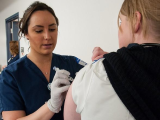Dec 3, 2010 – Uptake of seasonal flu vaccine has been encouraging so far, and with plenty of vaccine still available and most of the flu season still to come, the nation is in good position to boost immunization rates, officials from the US Centers for Disease Control and Prevention (CDC) said today.
Flu activity is increasing across the nation, with illnesses in southeastern states, especially Georgia, leading the way, Dr Ann Schuchat, director of the CDC's National Center for Immunization and Respiratory Diseases, told reporters at a press briefing. She said increasing flu activity may draw more attention to efforts surrounding the Dec 5 launch of National Influenza Vaccination Week, a national observance used over the past few years to foster greater use of flu vaccine in advance of the holiday season and into the new year.
CDC officials said they were struck by the stark difference from last year, when pandemic flu escalated quickly in early fall when seasonal vaccine supplies were less than expected and the pandemic vaccine arrived too late to blunt the second wave of illnesses.
Dr Howard Koh, assistant secretary for health at the US Department of Health and Human Services, said health officials hope to parlay some of the lessons learned during the H1N1 pandemic into clear messages to the public that flu is unpredictable and that anyone, even healthy people, can become severely ill from the virus. "This is our opportunity to really improve our emphasis on this important message," he said.
He noted that the messages mesh well with the CDC's new universal flu vaccination recommendation. This is the first flu season that the vaccine has been recommended for anyone age 6 months and older.
Regional activity in Georgia
Schuchat said the percentage of respiratory specimens testing positive for flu across the nation rose again last week, from 9.8% to 10.7%. Georgia became the first state to report regional flu activity, meaning the disease is active in multiple areas of the state.
Flu levels have increased sharply in southeastern states and are on the rise in western states, as well, Schuchat said. In Georgia, as in the rest of the nation, the highest percentage of isolates is influenza B, and specifically the Victoria lineage, which is a good match for the strain included in the seasonal flu vaccine, she said.
Puerto Rico and nine states (Alabama, Connecticut, Hawaii, Louisiana, Mississippi, New York, Oklahoma, Pennsylvania, and South Carolina) reported local influenza activity. No pediatric deaths were reported, flu and pneumonia deaths were below the epidemic threshold, and doctor's visits for flu-like illness were below the national baseline.
"There's usually a large increase in flu activity after the holidays, and now is the time to take action," Schuchat said. "About 160 million doses have been distributed, more than any other season."
Early survey shows 33% uptake
Also at the press conference the CDC unveiled results of a rapid flu survey that it conducted in mid-November and that Schuchat said provides an early snapshot of this season's flu vaccine uptake. Overall it showed 33% of Americans have already been vaccinated, with 15% responding they definitely plan to be vaccinated and 25% saying they probably would be immunized. The phone survey included about 38,000 adults and 9,100 children.
She said the CDC is encouraged by the numbers so far. "When we compare them with last year we're a little ahead," she said, noting that uptake is fairly strong, even without the nonstop pandemic flu messages that were the hallmark of last year's flu season.
About two–thirds of respondents were vaccinated in a medical office, hospital, or clinic, while about 16% were immunized at a pharmacy or other retail location, and about 18% got vaccine at the workplace or a school.
As in past flu seasons that occurred in non-pandemic years, seniors age 65 and older had the highest vaccine uptake rate at 64%, Schuchat said.
However, the survey also found that flu immunization rates are still lagging in minority groups, she said, noting that rates for whites are 10% higher than for blacks or Hispanics.
Schuchat said the vaccination week push is well timed to help boost flu vaccination rates in minority groups. "It's not too late to make a difference for more people who would benefit," she said.
A separate part of the survey detailed an Internet poll of vaccine uptake so far in healthcare workers and pregnant women. So far about 56% of healthcare workers have been vaccinated, and 7% more say they definitely plan to be immunized. Schuchat said four of five healthcare workers were vaccinated at their workplaces. Last year about 62% of healthcare workers received the seasonal flu vaccine, with about 37% receiving the 2009 H1N1 vaccine, according to previous CDC reports.
As for pregnant women, 45% of the 1,400 surveyed said they have already been vaccinated, with an additional 4% saying they intend to be vaccinated before their babies are due. Last year about half of pregnant women received the seasonal flu vaccine.
In a summaryof the survey findings, the CDC said the rapid flu survey is a pilot program designed to help it quickly collect vaccination data. The November survey is intended to allow the CDC to modify its strategies during the current flu season. The agency will conduct another rapid survey in March to gauge overall uptake. The rapid surveys are conducted for the CDC by the National Opinion Research Center (NORC) at the University of Chicago.
See also:
CDC National Influenza Vaccination Week Web page
Dec 3 CDC weekly flu surveillance report



















